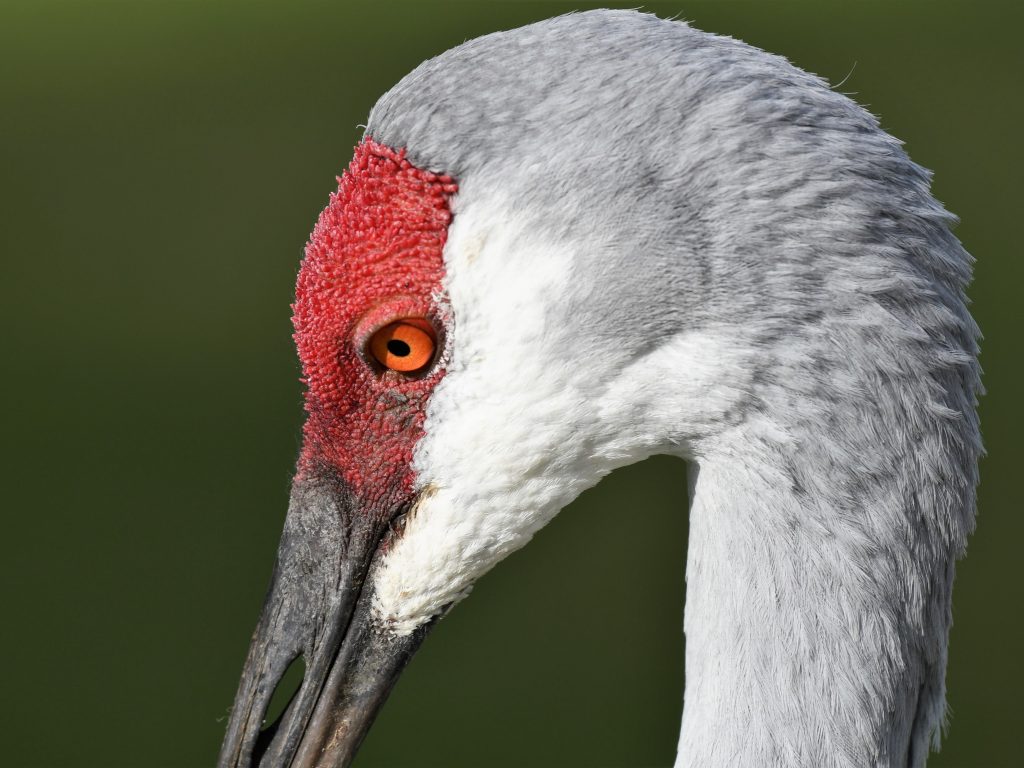Common Name: Sandhill Crane
Status: Native Species
Scientific Name: Antigone canadensis pratensis
Occurrence: Year-round Species
Identification: Sandhill cranes are among the largest and most recognizable birds in Florida. The Florida Sandhill crane stands around four feet tall, with a wingspan exceeding six feet, and weighs approximately ten pounds. Both males and females are similar in appearance, though males are typically slightly taller, heavier, and more aggressive when defending their mate or offspring.

Adults have long necks, long legs, and distinctive, drooping bushy tail feathers that are actually the bird’s elongated wing feathers. Their plumage is predominantly gray but may appear rusty-brown due to iron staining from preening with muddy water. They have a long, straight, black beak, yellow to reddish eyes, white cheeks, and a bright scarlet red crown on their heads, which is one of their most notable features. Juveniles, slightly smaller in size, have a rusty-brown crown that turns red as they mature. The young, called colts, are covered in yellowish-brown down and lack the distinctive red crown.
In flight, Sandhill cranes are easily identified by their outstretched necks and legs, contrasting with species like herons, which retract their necks. Their vocalization is also distinctive—a loud, rolling, trumpeting call that can be heard over long distances.
In comparison to other large birds, Sandhill cranes are slightly larger than Great Blue Herons but smaller than Whooping Cranes.

Description: Florida Sandhill Crane can be found in a variety of open habitats, from upland forests or scrub, marshes, open prairies, pastures, and residential lawns. Sandhill cranes to mate for life. Their courtship is quite unique. Sandhill crane courtship is a graceful and elaborate display, often involving a series of synchronized dances, bowing, and wing-flapping. Pairs engage in unison calling, where both the male and female throw their heads back and produce a loud, rhythmic duet. During their courtship dance, cranes will leap into the air, flap their wings, and toss sticks or grass in a playful manner. These courtship rituals help strengthen the bond between mates, which typically lasts for life. This dancing behavior can also be seen outside of the breeding season and is thought to play a role in reinforcing pair bonds year-round. Florida Sandhill cranes typically breed in late winter to early spring, nesting in marshes or other wetland areas. They build large nests out of vegetation, usually in shallow water. The female lays one to two eggs, which are pale brown with blotches of darker brown. Both parents share incubation duties, which last about 29-32 days. Once hatched, the chicks, known as colts, are precocial—able to walk and swim within hours. The young remain with their parents for up to 10 months, learning vital survival skills before becoming independent. Sandhill cranes usually only raise one successful chick per season.
Diet: Sandhill cranes are omnivorous birds with a diverse diet that includes both plant and animal matter. They have been observed eating seeds, grains, berries, and tubers, as well as reptiles, amphibians, small rodents, insects, and even small birds. This varied diet allows them to adapt to different habitats and seasonal food availability.

In residential areas, Sandhill cranes may be attracted to bird feeders and consume seed intended for smaller bird species. While it might seem harmless, feeding cranes can lead to negative behaviors and potential property damage. The birds can become habituated to humans, losing their natural wariness, which may result in them approaching people too closely or displaying aggression, especially during breeding season. They might peck at windows, vehicles, or other reflective surfaces, mistaking them for rivals or potential threats, causing scratches or other damage.
Feeding Sandhill cranes can also disrupt their natural foraging habits and dietary balance, potentially impacting their health. Wildlife authorities often advise against feeding these birds to prevent dependency on human-provided food sources and to minimize human-wildlife conflicts. Encouraging natural feeding behaviors helps maintain the cranes’ well-being and supports their role in the ecosystem.
Interesting Facts:
- Sandhill cranes are excellent parents and very protective of their young. They have been observed fiercely defending against predators such as alligators, coyotes, and cats by using their feet to kick. They will even defend against humans!
- The Greater Sandhill Crane is a migrant occurring from about October to March in numbers reaching around 25,000. It is a slightly lager subspecies.
- If a Sandhill Crane loses its mate, it will find another. Females have been observed to use the same nest after finding a new mate.
- It is illegal to intentionally feed a Sandhill Crane as according to (Florida Administrative Code 68A-4.001(6).
- The Cuban sandhill crane (Antigone canadensis nigriceps), is considered endangered.
- Sandhill Cranes come in different sizes depending on their location: the smallest, “Lesser” Sandhill Cranes, breed in the Arctic; the largest, “Greater” Sandhill Cranes, are found in the northern U.S.; while “Florida” Sandhill Cranes and those from central Canada fall in between. Regardless of size, their plumage remains similar.
- One of the most prevalent parasitic worms found in sandhill cranes is a fluke that infects the trachea. This parasite affects more than 40% of sandhill cranes and can impact their respiratory health.

Florida Sandhill Crane. Location: Valrico, Hillsborough County. Photo: Jim E. Davis
Pictures may not be used unless receive written permission from Jim E. Davis
Pictures must be used for educational purposes only.
References: https://myfwc.com/wildlifehabitats/profiles/birds/cranes/sandhill-crane/
https://www.allaboutbirds.org/guide/Sandhill_Crane/overview
https://www.audubon.org/field-guide/bird/sandhill-crane
https://vetmed.tamu.edu/schubot/research/disease-risks-to-whooping-cranes-and-sandhill-cranes/
https://edis.ifas.ufl.edu/publication/UW493
 8
8

